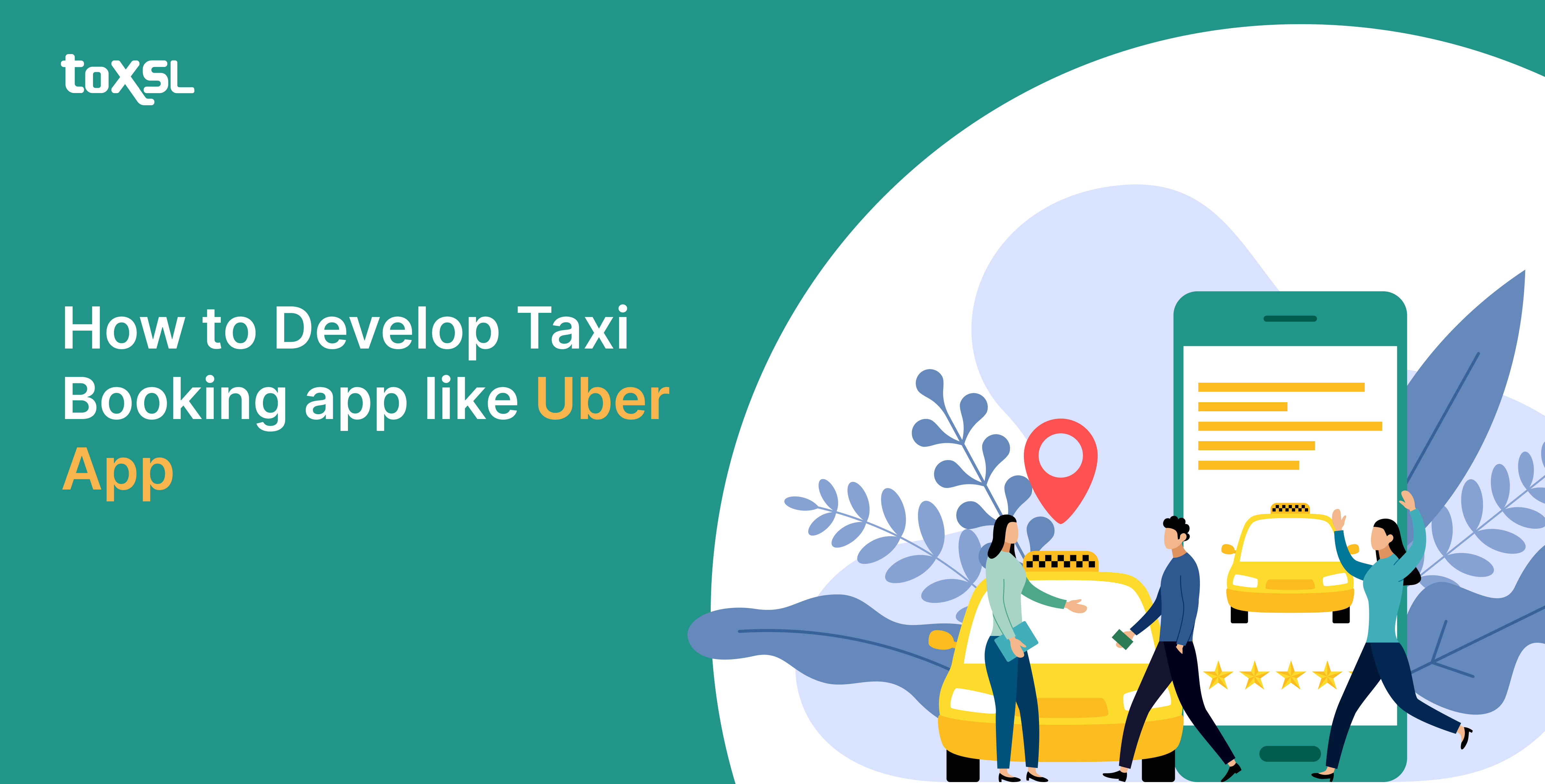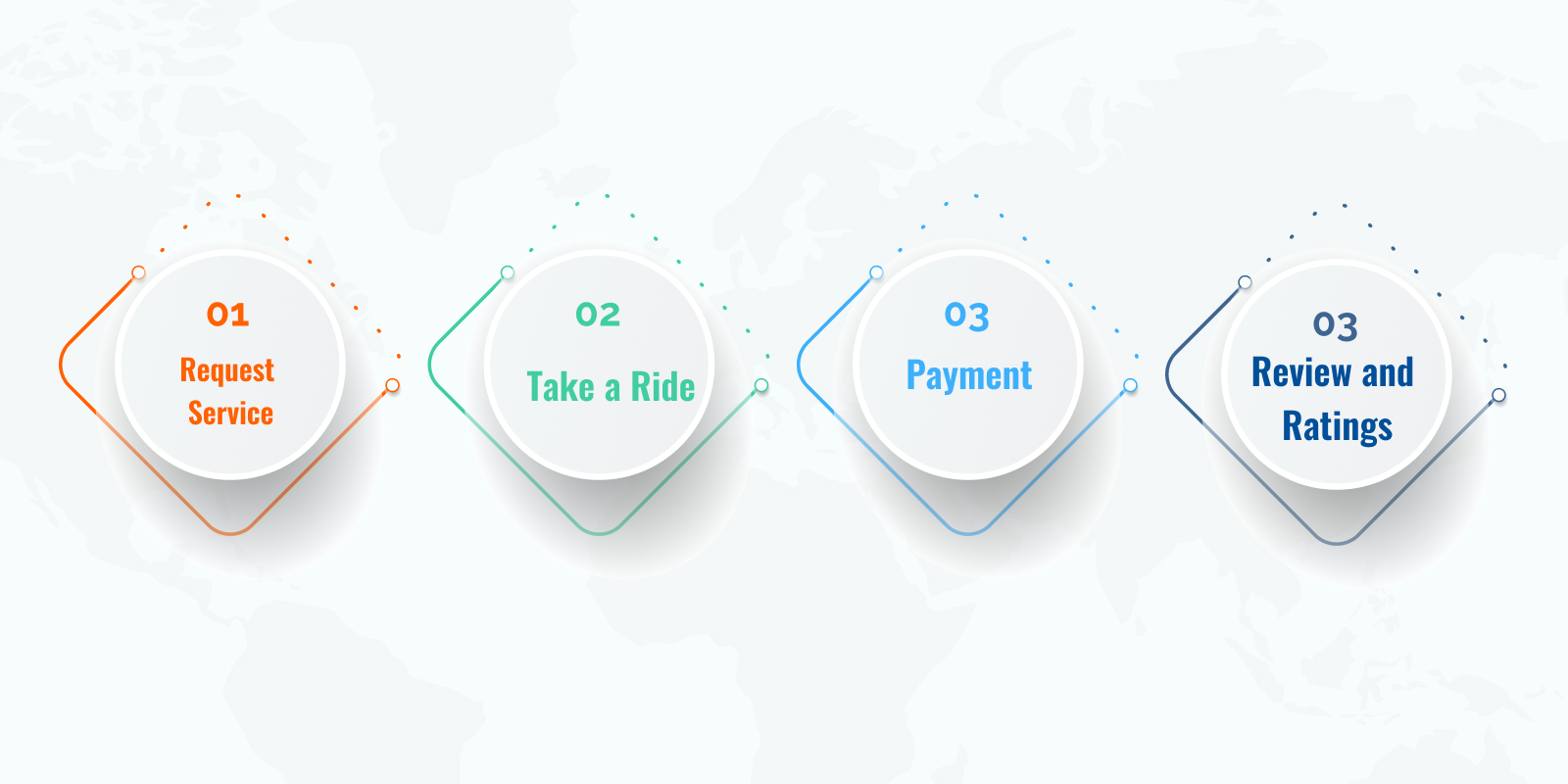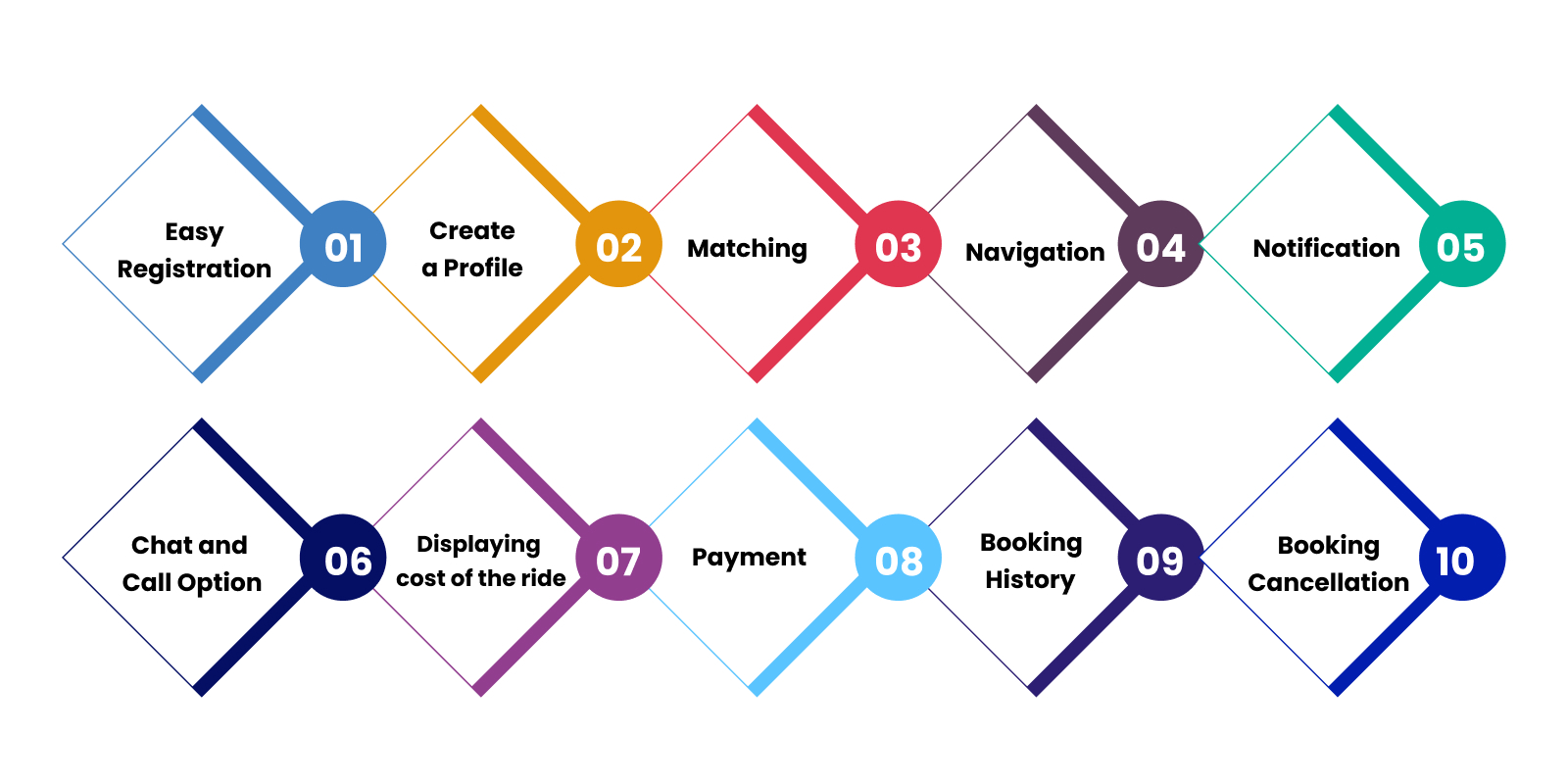- Jul 14, 2025
Share this post on:

In the past times, there were a lot of traveling issues faced by people, but with the advent of technology, there is a drastic shift in consumer needs that values convenience. Taxi booking App is a perfect solution through which people can hire a taxi where and whenever needed!
Taxi app development is one such service that saves your time & cost by providing you with user-friendly solutions for your mobile phones. The business makes great sense, as it frees people from driving their vehicles in exhausting traffic.
Statista predicts that by 2025, the annual growth of the global market for ride-hailing services will reach $126,521 million. The concept of Taxi Booking eased the daily commute of the users while allowing them to book a cab with a single tap.
These apps are getting popular, let us quickly understand the business and get a complete guide all the way through so that you know the required ins and outs.
Why Developing an App for Taxi Business is a Good Choice?
There are many benefits offered to your company if you are looking forward to investing in a Taxi Booking App Development Services. Let us discuss a few of the details:
1. Gives You a Wider Opportunity
The transportation industry has already taken a new shape. The Taxi app offers a great opportunity for service providers to operate their businesses and services via mobile applications. With the advent of search engines and on-demand apps, people turn out for your services. Thus offering wider growth and opportunities for your business.
2. Real-Time Updates and Transparency
One of the greatest advantages it offers is that are no chances of miscommunication. When your booking services operate via the on-demand app, you get real-time updates regarding cab availability. Also, the drivers have complete control of whether to accept or decline the ride offer in real time.
3. Business is Automated
The on-demand business can automate the whole process and eliminate the dependency of businesses on their phone operators. The need for human interaction is reduced from the entire process, which also reduces the administration cost and increases the business profitability.
4. Better Value Proposition
When you hire expert developers to create an application, you offer a better user experience and interface to the customers, which helps to emphasize better value propositions.
Do you want to create a Taxi App? Get our Consultation and App Cost Estimate.
How does a Taxi Booking App like Uber work?
The Taxi Booking apps like Uber have made a revolutionary change in the market of Taxi services. The flow includes the following steps:

1. Request Service
The user opens the app and enters the departure and arrival address along with the payment method.
When the driver receives a request from a user, they can check the real-time location of the car. In case the driver rejects the request, it would further be allocated to the nearby driver, and so on.
2. Take a Ride
You would be able to check in real time where the car is going. When the user sits in the car, the driver starts the ride on the app.
3. Payment
The users can link their debit/credit cards to the application. The passenger knows the cost of the ride before booking the cab, and the amount gets deducted once the ride is finished.
4. Review and Ratings
Users and drivers can leave their reviews in the application. It gives an impression about the driver, and they are more alert before taking their next ride.
Must-have features for both Driver and Passenger Apps

1. Easy registration
The app should offer quick and easy registration via email/password login functionality. There should be an option to sign-in via social media as well. It is the foremost screen a user gets when the app is downloaded. Therefore, it should be simple for the users to improve customer retention.
2. Create a Profile
The users and drivers should be able to make changes, and modify their profiles by adding their names, phone numbers, email addresses, clear pictures, and Vehicle numbers (for the driver). The driver and user should be able to visit one another’s profiles so that they can identify each other at the pickup location. This gives the user a sense of security!
3. Matching
The feature allows the users to connect to the nearest driver available. It considers several factors such as the location of the user, the driver's previous drop-off, car model, status, and much more.
4. Navigation
With this feature, the user and driver can identify their current locations while tracking the movements of their car, the cost of the ride, and the estimated time of arrival. All these data sets are sent to the server for further processing and broadcasting to other users in that particular area.
5. Notification
Taxi applications use options such as SMS, push notifications, and e-mail. It allows the user to stay updated with the latest features, coupons, and discounts in the application if there are any.
6. Chat and Call Option
The driver and user can communicate with each other via call/chat options while taking care of their privacy. There is an integrated chat option that works usually like other normal messengers without sharing any personal details.
Also, there is a calling option within the application, here the system generates a random number and allows them to call each other.
7. Displaying cost of the ride
The driver and the user are updated with the estimated cost of the ride. The actual fare may vary depending on the server and may depend on factors like pick up, drop, traffic, car type, and more.
8. Payment
The app should be securely able to accept payments made via the application. As the payments are cashless, it is withdrawn automatically via the payment gateway.
9. Booking History
Both the driver and passenger should be able to view the detailed preview of their previous trip along with the cost, time, car model, drop-off location, etc.
10. Booking Cancellation
Both Driver and User should be allowed to cancel the ride, and a cancellation fee is generally charged.
Features for Passenger App
The passenger should be able to track the nearby drivers available at that time.
They should be able to set the pickup location without having to enter it manually.
Users should be able to see the relevant information such as Driver’s name, Car number, Car model, location in real-time, and ETA.
They should be notified once the Taxi arrives at the place.
Should be able to select the vehicle model as per their preference.
Favorite addresses for convenient future bookings
Features for Driver App
Location of the user on the map.
Relevant information about the user
Should be able to accept or reject user requests based on preference
Can go to offline mode when not working
Advanced route optimization
How does Uber make money?
Bored with the technical part and the features you need to integrate? Let us move to revenue generation. But how can you generate income from your application?
The Taxi Booking Application allows users to earn via two revenue streams. Here they are:
- Commissions from users
The earnings of the driver are shared with the app owner, and approximately 20% of the commission is given per ride. Also, if the user cancels the ride, they are charged the additional fee that goes to the app owner. - Ads and promotions
Promoting other brands or services on your application offers a great way of earning. You will get money with a cost-per-click or similar model.
Collaboration with famous brands offers a great source of earning!
How to get started?
If you are a Taxi company and looking to enhance your business with the Taxi App Development Services, do check out our portfolio for the same. We offer fully customized and branded solutions that are competent enough to carry out your project successfully.
Our taxi solution experts team will work closely with you to deliver a customized solution for your taxi business.
How to Start a Taxi Business
1. Conduct Market Research
Before launching, it's essential to understand the local transportation landscape. Analyze your target area for demand patterns, peak hours, competition (traditional taxis and app-based services), pricing standards, and customer pain points. This helps you identify the best routes, pricing strategy, and potential service gaps you can fill.
2. Register Your Business
Choose a legal structure (e.g., sole proprietorship, partnership, or LLC) and register your taxi business with the appropriate local authorities. This step includes securing a business name, applying for a tax ID, and opening a business bank account. Legal registration also allows you to operate with credibility and access financial services like loans or grants.
3. Obtain Licenses and Permits
Compliance is critical. You’ll need to apply for commercial vehicle licenses, taxi operator permits, driver IDs, and other transport authority certifications depending on your city or country. In some regions, drivers may also need to pass special exams or background checks.
4. Buy or Lease Vehicles
Decide whether you'll operate a company-owned fleet or partner with individual vehicle owners. Choose vehicles based on reliability, fuel efficiency, passenger comfort, and maintenance costs. If you're going eco-friendly, consider hybrid or electric cars to reduce fuel expenses and appeal to environmentally conscious customers.
5. Equip Your Fleet
Install necessary hardware in each vehicle, such as GPS devices, fare meters, emergency buttons, dashcams, and branding elements (taxi lights, decals, etc.). Ensuring each car meets safety standards builds customer trust and supports regulatory compliance.
6. Develop a Booking App or Use a Platform
Modern taxi businesses thrive on technology. You can either develop a custom mobile app or use a white-label solution that allows users to book rides, track drivers, and pay securely. Key features should include live GPS tracking, estimated arrival times, fare calculators, in-app payments, driver reviews, and customer support.
7. Hire Trained and Licensed Drivers
Your drivers represent your brand. Hire professionals with clean driving records, valid licenses, good customer service skills, and knowledge of the local area. Train them in app usage, communication, safety protocols, and company policies to ensure consistent quality.
8. Get Insurance Coverage
Protect your business, vehicles, drivers, and passengers with the right insurance. Typical policies include commercial vehicle insurance, liability coverage, accident coverage, and worker’s compensation. Some insurers offer specific packages for taxi fleets.
9. Create a Competitive Pricing Strategy
Set transparent and competitive pricing that reflects your service quality while staying affordable for your target audience. Consider fixed rates for airport runs or surge pricing during peak hours. Always disclose pricing clearly to avoid disputes.
10. Launch Marketing and Promotions
Promote your taxi business through multiple channels. Use social media, local SEO, Google Ads, community events, and partnerships with hotels or businesses. Offer discounts for first-time users, referral rewards, or loyalty programs to attract and retain riders.
11. Ensure Customer Support and Safety
Offer 24/7 customer service through chat, phone, or email. Add safety features like SOS buttons in the app, ride tracking for family/friends, and in-app feedback systems. Address complaints promptly and use feedback to improve service quality.
12. Maintain and Scale the Business
Keep your vehicles well-maintained and your drivers motivated. Monitor performance metrics like trip completion rate, customer ratings, and average wait time. As your business grows, explore expanding to new locations, offering premium services, or introducing carpooling options.











